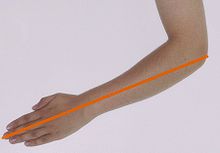Our website is made possible by displaying online advertisements to our visitors.
Please consider supporting us by disabling your ad blocker.
Ell
This article includes a list of general references, but it lacks sufficient corresponding inline citations. (November 2022) |
| Ell | |
|---|---|
 The ell was originally a cubit, later replaced by the cloth-ell or "double ell". | |
| General information | |
| Unit of | Length |
| Conversions (imperial) | |
| 1 imp unit in ... | ... is equal to ... |
| Inch | 45 |
| Metre | 1.143 |


An ell (from Proto-Germanic *alinō, cognate with Latin ulna)[1] is a northwestern European unit of measurement, originally understood as a cubit (the combined length of the forearm and extended hand). The word literally means "arm", and survives in the modern English word "elbow" (arm-bend). Later usage through the 19th century refers to several longer units,[2][3] some of which are thought to derive from a "double ell".[4][5]
An ell-wand or ellwand was a rod of length one ell used for official measurement. Edward I of England required that every town have one. In Scotland, the Belt of Orion was called "the King's Ellwand".[6][7] An iron ellwand is preserved in the entrance to Stånga Church on the Swedish island of Gotland, indicating the role that rural churches had in disseminating uniform measures.[8]
Several national forms existed, with different lengths, including the Scottish ell (≈37 inches or 94 centimetres), the Flemish ell [el] (≈27 in or 68.6 cm), the French ell [aune] (≈54 in or 137.2 cm),[9] the Polish ell (≈31 in or 78.7 cm), the Danish alen (24 Danish inches or 2 Danish fod: 62.7708 cm), the Swedish aln (2 Swedish fot 59.38 cm) and the German ell [Elle] of different lengths in Frankfurt (54.7 cm), Cologne, Leipzig (Saxony) or Hamburg.
Select customs were observed by English importers of Dutch textiles; although all cloths were bought by the Flemish ell, linen was sold by the English ell, but tapestry was sold by the Flemish ell.[9]
The Viking ell was the measure from the elbow to the tip of the middle finger, about 18 inches (460 mm). The Viking or primitive ell was used in Iceland up to the 13th century. By the 13th century, a law set the "stika" as equal to two ells, which was the English ell of the time.[10]
- ^ "ell, n.1". OED Online. December 2011. Oxford University Press. (accessed February 20, 2012).
- ^ The Diagonal. Yale University Press. 1920. p. 98. Retrieved 6 February 2012.
- ^ Charlton Thomas Lewis; Hugh Macmaster Kingery (1918). An elementary Latin dictionary. American book company. p. 198. Retrieved 6 February 2012.
forearm, ell, cubit.
- ^ James Robinson (of Boston.) (1857). The American elementary arithmetic. J.P. Jewett & co. p. 94. Retrieved 6 February 2012.
- ^ Daniel O'Gorman (1853). Intuitive calculations; the readiest and most concise methods. p. 48. Retrieved 6 February 2012.
- ^ infoplease.com, OED s. Ell-wand.
- ^ AR Littlewood. "The measurements of cricket". ESPN cricinfo.
- ^ Andrén, Anders (2017). Det Medeltida Gotland. En arkeologisk guidebok [Medieval Gotland. An archaeological guidebook] (in Swedish) (2nd ed.). Lund: Historiska Media. p. 206. ISBN 978-91-7545-476-4.
- ^ a b Brayshaw, Tom S., ed. Brayshaw's Mathematical Desk Companion. Chesterfield, England: Thomas Brayshaw Ltd., Edition 16, 1955
- ^ Nancy Marie Brown (2007). The Far Traveller: Voyages of a Viking Woman. Harcourt. pp. 236, 276. OCLC 85822467.
Previous Page Next Page


